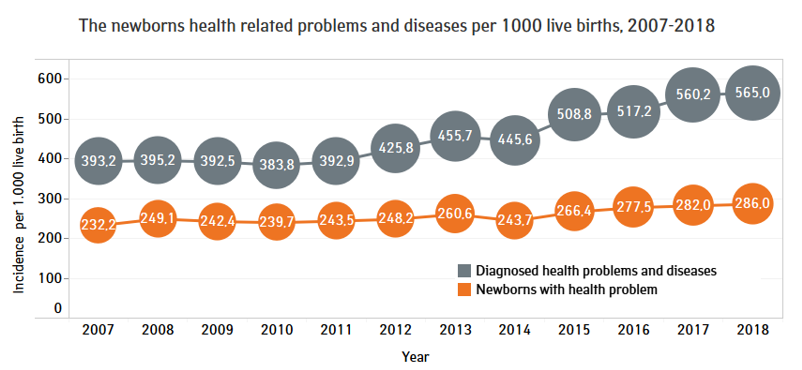Health care providers 2018
26 SEPTEMBER 2019
Data about health care providers by type of owner and legal form, and also dental care providers and treatment possibilities by county in 2018 were published in the Health Statistics and Health Research Database. Data is available in database tables TTO10, TTO11, TTO40 and TTO60.
There were 1434 independent health care providers at the end of 2018 in Estonia, including 53 hospitals, 441 family doctor's offices, 487 dental care providers, 309 specialist health care providers and 144 other health care providers. In 2018, 51 independent health care providers started and 58 completed their activities. Compared to previous year (2017) 3 specialist care providers has added, but the number of family doctor’s offices has decreased by 11.
Table TTO40 shows data about dental care providers. There were 539 dental care providers at the end of 2018, of which 487 were independent dental care providers. Compared to 2017, the number of dental care providers decreased by 3. One tenth of the dental care providers offer also other health care services beside dental care and that number has been on the same level over the past years. Just over 40% of all dental care providers are in Tallinn and about one tenth in Tartu. 99% of clinics offer dental care, it means that only 1% of dental care clinics are specialized solely in prosthetic treatment, orthodontic treatment, dental surgery procedures or x-ray examinations. In 2018, 71% of dental care providers offered prosthetic services, 11% orthodontic services, 93% endodontic services, 72% parodontic services, 49% dental surgery procedures and 80% x-ray examinations.
Database table TTO60 shows data about health care providers in e-health system. By 2018, 1414 health care providers have joined with the e-health system which makes up 98.6% of all health care providers in Estonia. Compared to the previous year the number of health care providers that has sent data to e-health increased by 16 and the total number is 1108 providers.
Incidence of newborns 2018
25 SEPTEMBER 2019
According to the data from Estonian Medical Birth Registry, 14,235 live births were in 2018. Of those, 4,075 were born with a health-related problem or disease.
The incidence rate of newborns per 1,000 live births is increasing year by year. In 2018, the incidence rate per 1,000 newborns was 286. A newborn baby may have multiple health related problems or conditions. The average number of diagnoses per one newborn was 2.
Data about incidence of newborns is available here.
Data about livebirths is published here, stillbirths statistics is published here.
Cancer screening programmes coverage by examination, 2018
29 AUGUST 2019
In 2018, 52.8% of women attended mammography screening, who were invited to breast cancer screening programme in Estonia. The screening coverage was lower among those, who were invited to cervical cancer or colorectal cancer screening – 45.3% and 50.1% respectively, according to data of National Institute for Health Development.
Estonian Cancer Screening Registry's 2018 data about cancer screening programme target population and coverage by examination is published in Health Statistics and Health Research Database.
Life expectancy and healthy life years, 2018
09 SEPTEMBER 2019
According to Statistics Estonia, in 2018, life expectancy at birth was 73.9 years for males and 82.4 years for females. Life expectancy has increased for both sexes, slightly more for males. Men are expected to live disability-free for 52.8 and women for 55.6 years. Just a year ago, disability-free life expectancy for males was two years longer and for females over three years longer.
Continue reading Statistics Estonia news.
Infant breastfeeding, 2018
01 AUGUST 2019
In Estonia, 65% of three months old and 24% of six months old infants were exclusively breastfed* in 2018. Compared to previous year, the indicator of infants breastfeeding in 2018 was similar – three months old infants who were exclusively breastfed increased by 1 percentage point and for the indicator of six months old infants increased by 0.4 percentage points. Both indicators of infants at six and twelve months of age who were exclusively and/or partially breastfed also increased by 2 percentage points, reaching 72 and 34 percent of infants up to the age of one respectively.
Compared to 2013, six months old infants who were exclusively breastfed has decreased by 18 percentage points, but the increase took place for partially breastfed twelve months old infants by 9 percentage points.
Infant breastfeeding data is published at Health Statistics and Health Research Database, tables SR90 and SR91.
*Exclusively breastfed infants — infants who are fed exclusively with breast milk (incl. pumped breast milk). Additionally, they may get vitamins and medicaments, but not tea, water, juice, infant formulas or anything else what would replace meal.

